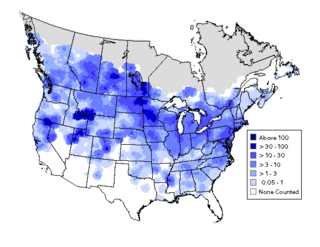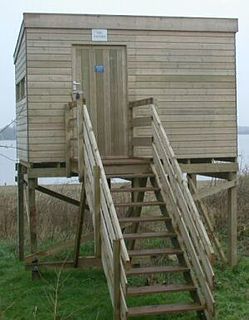 W
WAfocal photography, also called afocal imaging or afocal projection is a method of photography where the camera with its lens attached is mounted over the eyepiece of another image forming system such as an optical telescope or optical microscope, with the camera lens taking the place of the human eye.
 W
WThe Atlas of Australian Birds is a major ongoing database project initiated and managed by BirdLife Australia to map the distribution of Australia's bird species. BirdLife Australia is a not-for-profit bird research and conservation organisation.
 W
WBal-chatri are traps designed to catch birds of prey (raptors). The trap essentially consists of a cage baited inside with a conspicuously visible live rodent or small bird, with a series of monofilament nooses attached to the surface to snare the legs of a free-flying raptor that attempts to take the bait. The name is derived from the Hindi word used by trappers in India. Modified bal-chatri traps are also used for catching shrikes.
 W
WA bird atlas is an ornithological work that attempts to provide information on the distribution, abundance, long-term change as well as seasonal patterns of bird occurrence and make extensive use of maps. They often involve a large numbers of volunteers to cover a wide geographic area and the methods used are standardized so that the studies can be continued in the future and the results remain comparable. In some cases the species covered may be restricted to those that breed or are resident. Migration atlases on the other hand cover migratory birds depict maps showing summaries of ringing and recoveries.
 W
WA bird hide is a shelter, often camouflaged, that is used to observe wildlife, especially birds, at close quarters. Although hides or hunting blinds were once built chiefly as hunting aids, they are now commonly found in parks and wetlands for the use of birdwatchers, ornithologists and other observers who do not want to disturb wildlife as it is being observed.
 W
WBird measurement or bird biometrics are approaches to quantify the size of birds in scientific studies. The measurements of the lengths of specific parts and the weights of birds varies between species, populations within species, between the sexes and depending on age and condition. In order for measurements to be useful, they need to be well defined so that measurements taken are consistent and comparable with those taken by others or at other points of time. Measurements can be useful to study growth, variation between geographically separated forms, identify differences between the sexes, age or otherwise characterize individuals birds. While certain measurements are regularly taken in the field to study living birds some others are applicable only to specimens in the museum or measurable only in a laboratory. The conventions used for measurement can vary widely between authors and works, making comparisons of sizes a matter that needs considerable care.
 W
WBird ringing or bird banding is the attachment of a small, individually numbered metal or plastic tag to the leg or wing of a wild bird to enable individual identification. This helps in keeping track of the movements of the bird and its life history. It is common to take measurements and examine conditions of feather molt, subcutaneous fat, age indications and sex during capture for ringing. The subsequent recapture or recovery of the bird can provide information on migration, longevity, mortality, population, territoriality, feeding behavior, and other aspects that are studied by ornithologists. Other methods of marking birds may also be used to allow for field based identification that does not require capture.
 W
WThe Blossom Expedition was a collecting expedition that principally procured ornithological specimens from Africa, South America, and the islands of the South Atlantic Ocean for the collections of the Cleveland Museum of Natural History. The expedition was initiated by Leonard Sanford, with museum trustee Elizabeth Blossom serving as its eponymous benefactor.
 W
WDigiscoping is a neologism for afocal photography, using a (digital) camera to record distant images through the eyepiece of an optical telescope.
 W
WA duck decoy is a device to capture wild ducks or other species of waterfowl. Formerly the birds were slaughtered and used for food. Decoys had an advantage over hunting ducks with shotguns as the duck meat did not contain lead shot. Consequently, a higher price could be charged for it.
 W
WAn Emlen funnel is a bird cage shaped like an inverted cone, used to study bird behaviour, in particular birds' migratory instincts. It is named after S T and J T Emlen who introduced the technique in 1966. An ink pad is placed on the bottom, so when the bird hops or flutters onto the sloping walls it leaves a track before slipping back down again. The bird's view through the top of the cage can be manipulated to show how it responds to different apparent "star patterns".
 W
WThe Harold Hall Australian expeditions comprise a series of five main ornithological collecting expeditions carried out in the 1960s and covering much of the Australian continent.
 W
WA Heligoland trap is a large, building-sized, funnel-shaped, rigid structure of wire mesh or netting used to trap birds, so that they can be banded or otherwise studied by ornithologists.
 W
WThe ICARUS Initiative, short for International Cooperation for Animal Research Using Space, is an international effort to track the migratory patterns of small flying animals using satellite imagery. The project began in 2002 and the tracking system was installed on the International Space Station (ISS) in August 2018, switched on in July 2019, and began operations in September 2020. The director for the ICARUS project is Martin Wikelski, director of the Max Planck Institute of Animal Behavior in Radolfzell, Germany.
 W
WThe Lake Bant tern colony is a breeding colony of common terns at Lake Bant in the port city of Wilhelmshaven, north-western Germany. It is the subject of a long-term research project carried out by the Institute of Avian Research.
 W
WA light level geolocator, light-level logger or GLS is essentially a lightweight, electronic archival tracking device, usually used in bird migration research to map migration routes, identify important staging areas, and sometimes provide additional ecological information. A geolocator periodically records ambient light level to determine location.
 W
WMist nets are used by ornithologists and bat biologists to capture wild birds and bats for banding or other research projects. Mist nets are typically made of nylon or polyester mesh suspended between two poles, resembling a volleyball net. When properly deployed in the correct habitat, the nets are virtually invisible. Mist nets have shelves created by horizontally strung lines that create a loose, baggy pocket. When a bird or bat hits the net, it falls into this pocket, where it becomes tangled.
 W
WA nest box camera, also known as a bird box camera, is a photographic device fitted inside a nest box in order to monitor its inhabitants. Many Internet sites broadcast video streams and still images of nesting birds in real time.
 W
WA bird observatory is a centre for the study of bird migration and bird populations. They are usually focused on local birds, but may also include interest in far-flung areas. Most bird observatories are small operations with a limited staff, many volunteers and a not-for-profit educational status. Many bird observatories conduct bird ringing or bird banding.
 W
WRocket nets and cannon nets are types of animal traps used to trap many live animals, usually birds, but they also have been used to catch large animals such as various species of deer. Rocket nets, cannon nets, and other net launching devices are built upon similar principles have been used since the 1950s.
 W
WSeawatching is a type of birdwatching where participants observe seabirds from a fixed point on the mainland. They may do this from a coastal location, usually a headland, looking out to sea, or from a boat or ship.